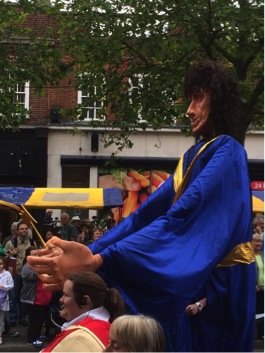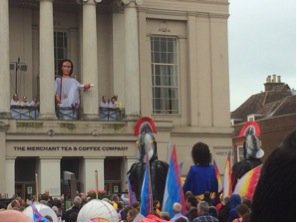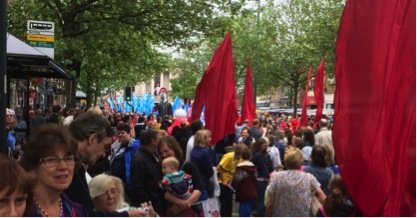Puppets and a pilgrimage
Mark Freeman
Last Saturday – 20 June – I went to see the annual puppet re-enactment of the martyrdom of St Alban, the first Christian saint in Britain. This is organised by St Albans Cathedral, and attracts hundreds, if not thousands, of spectators. The archbishop of Canterbury was present and made a short speech at the start of the event, and various church dignatories were also in attendance.
The re-enactment is not a historical pageant as such, but it presents the story of Alban’s martyrdom in three episodes – arrest, trial and beheading – with a procession in between. The main characters take the form of giant puppets, similar to those used in processional pageants at Carlisle, Chester and elsewhere.

Above: St Alban in giant puppet form. (Author)
The first scene took place outside St Peter’s Church, the second in front of the town hall, and the third at the cathedral itself, which is believed to be on the site of the martyrdom. In previous years a
more ‘authentic’ route has been used, with the procession travelling to the cathedral from the site of the Roman city of Verulamium where Alban lived (he was a Roman soldier).

Above: The trial of Alban re-enacted outside the (nineteenth-century) town hall. (Author)
Pilgrimages move with the times. In the medieval period, pilgrims could buy souvenir badges from the abbey church at St Albans. Today, although badges and similar souvenirs remain available, there are Facebook pages and Twitter hashtags (#AlbanPilgrimage) to help share and remember the events of the day. You can see one of the cathedral’s own tweets here.
The martyrdom of the man from whom the city takes its name was portrayed in two of the four St Albans pageants – in 1907 and 1948 – but not in 1953 or 1968. In the last pageant there was a lively depiction of the battle between the monks of St Albans and Ely for custody of his relics. In the Alban pilgrimage re-enactment, a relatively recent innovation, the story is presented for public consumption once more.

Above: Crowds with banners in St Peter's Street. (Author)
I missed the last scene because of car parking restrictions – it was difficult to get into the car parks, and I only had an hour. Traffic congestion was a particular problem because of the lack of trains between London and St Albans all weekend.
I’m not just complaining. This is a useful reminder of one of the prosaic but significant features of pageants: transport. By the 1950s it had become increasingly important for pageant organisers to consider the needs of drivers – and additional car parking space was made available at most pageant grounds. I’m sure this is a theme that we will return to in due course!
